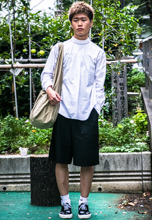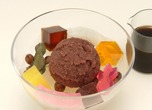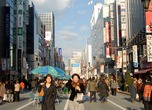
Posted: Wed Apr 28 2010
Tokyo is the city of ever changing buildings; even cultural institutions aren’t immune to the constant levelling and rebuilding. Sadly for some, the venerable Kabuki-za theatre will be closing for three years following a gala farewell ceremony to be held on April 30, 2010. Although the storied theatre is a registered tangible cultural asset, it’s slated for renovation due to advancing age – compared to most buildings in the city, it’s heading towards ancient.
The Kabuki-za first opened in Higashi-Ginza in 1889, having undergone several bouts of remodelling in the following decades. Its current incarnation made its debut in 1925, and then was destroyed during the Great Tokyo Air Raid. Luckily, the theatre’s framework survived, and the structure was able to be faithfully restored.
The current (and some say controversial) project is planned to be completed in 2013. The exact details have yet to be hammered out, but the general plan calls for the theatre to be transformed into a barrier-free, eco-friendly skyscraper that still incorporates the beloved and iconic Azuchi-Momoyama style lower level exteriors.
A proposed underground shopping complex will connect the theatre to Higashi-Ginza station on the Hibiya Line of the Tokyo Metro system. Whether or not the well-known shops that are currently part of the theatre’s dining and retail spaces will be part of this complex remains to be seen – everything is up in the air.
Tickets for the final performances and gala maybe long sold out, but there are still chances to get your hands on mementos and other items connected with the Kabuki-za and its long heritage. We’ve even tracked down some spots where you can keep shopping even after the last curtain has fallen, so check them out while you still have the chance.
No ticket? No problem: Matsuzakaya, Ginza
Despite the fact that the specialty shops inside the theatre are only accessible to those with tickets (even a single show ticket won’t going to get you into the shopping area), there is still a chance to get your hands on the farewell memorabilia you desire: there are plans to sell selected goods and food at the nearby Ginza branch of the Matsuzakaya department store.
In addition to the standard fare that one would expect, there’s talk of making mushi-kintsubaya (sweetened beans wrapped in steamed wheat-flour dough), kabuki-age (rice crackers), decorative hand towels as well as a specially designed memorial plate and photography catalogues available.
Daikokudo’s Ningyo-yaki, a Kabuki-za specialty
If you have a hankering for some Kabuki-za specialty confectionaries, then the Daikokudo Ningyo-yaki stand located in the first floor, west-wing sales area is the place for you. Daikokudo’s tremendous craftsmanship has been on display in the theatre’s retail space for almost thirty years now.
Even though Daikokudo modelled their Ningyo-yaki sweets on the seven deities of good luck, only six types are actually available. Daikoku (the god of wealth), Ebisu (the god of fishing and commerce), Bishamonten (the guardian god), Hotei (the pot-bellied god of good fortune), Fukurokuju (the tall-foreheaded god of happiness, wealth, and long life) and Benten (the goddess of arts and wisdom) are all represented. Noticeably absent is Jurojin (the god of longevity); ask any regular visitor to the Kabuki-za and they’ll tell you the answer to the mystery of the missing deity goes something like this: Jurojin has been intentionally left out to make room so that you, the valued customer, can round out the posse of seven.
A bag full of Ningyo-yaki make for a great present, but make sure you try a few yourself while they’re still piping hot. There are several flavours (mostly an bean based) to choose from, with koshi-an (bean paste), an-nashi (bean-less), matcha-an (green tea flavoured), yuzu-an (citrus flavoured), goma-an (sesame flavoured), and sakura-an (cherry blossom flavoured) to name a few. If you’re lucky enough to have snagged a ticket to one of the final performances, make sure to follow in the long tradition of enjoying these confections during the intermission.
The sweets even have a level of detail that goes beyond the actual ingredients; there is a certain charm to the Benten cake as her face bears a slight resemblance to Cat Girl of GeGeGe no Kitarou fame. Daikokudo’s flagship shop is in Tokyo’s Ota ward, so you can indulge yourself of their sweets even during the Kabuki-za theatre’s hiatus.
Hinemosu’s Kaiun-kodzuchi for all of your lucky charm needs
If you’ve ever visited the Kabuki-za, you might have heard a well-modulated voice rising up and hawking goods from the back corner of the theatre’s first floor, west-wing sales area: being sold are Hinemosu’s kodzuchi (small mallets). At first glance you would think they were all just run of the mill key chains, or even decorative straps for mobile phones, but hidden inside each of these kodzuchi is one of ten types of miniature (only about two centimetres in length each) talismans that are meant to invite good luck. The artisan uses his powerful oratory voice to poetically explain the significance of his work as he skilfully nestles the charms into the kodzuchi.
The ten charms are modelled after Ebisu, Daikoku, Hyotan (a gourd, symbolic of longevity and good fortune), kaeru (the frog, symbolic of a safe journey home), saikoro (lucky dice), koban (a traditional Japanese oval gold coin), nanten (heavenly bamboo), hamaya (a ceremonial arrow used to drive off evil), Tanuki (the raccoon-dog with the giant ‘lucky’ scrotum), and Daruma (a figure symbolic of good luck, hope, and optimism). They are each not much bigger than a grain of rice, and as he inserts them into the kodzuchi the artisan-cum-raconteur eloquently explains the secret behind their powers of good luck. Take the lucky dice, for example: ‘Let them fall where they may, luck will always be in your favour.’ There’s the suggestion in these words that with this kind of talisman in one’s possession one will prove to be successful no matter what one endeavours to accomplish. One cannot help then but to take the hint that it might be in your best interest to invest in one or two of them. If you’re prone to lending yourself to a bit of superstition, even the sound of the dice rattling inside the kodzuchi seems to portend of good things to come. While the Kabuki-za is closed you can find them for a limited time only at stands in department stores across Japan, or you can place an order through Hinemosu’s website.
Website: hinemosu.jp/
A taste of Edo through Tsukuhou’s Tsukudani
Tsukuhou has been maintaining the traditional flavours of their products since the time of Kabuki’s origin all the way back to the Edo period. You can get your own taste of their tsukudani (preserved food boiled in soy), the first of its kind to receive an attestation from The Bureau of Industrial and Labor Affairs, from their stall located in the Kabuki-za’s first floor, east-wing sales area. The exquisite flavour of their tsukudani is the sum of the time-honoured traditions and masterful skills that have been handed down within the company for generations – not unlike how kabuki’s greatness can be traced to the traditions and skills that have been handed down from one legend to the next. In any event, they make for a truly traditional souvenir commemorating a visit to the Kabuki-za, or to Tokyo. Don’t miss out on their fukimame (fava beans), which come highly recommended by renowned food journalist Asako Kishi. During the Kabuki-za remodelling, you can find Tsukugyoku’s products at their flagship shop and their Sugamo branch.
Kasho Okina’s Maccha Kingyokukan
These traditional Japanese confectionaries are only found at this 110-year-old stall located in the Kabuki-za’s first floor, east-wing sales area. The inside of the sweets consists of a gelatine made using lavish amounts of only the finest of Sayama matcha (powdered green tea), while the outside is covered in a delightfully crunchy layer of sugar. All it takes is one bite, and you will be pleasantly overwhelmed by the wonderfully rich flavour of matcha. The shop doesn’t plan on conducting business during the theatre’s closing, so try them now – or be prepared to wait three years.
For lunch nostalgia at the Kabuki-za Tea House, ‘Kabuki-za Chubo’
You can find the same kind of oridzume bento you had at the Kabuki-za Tea House at Kabuki-za Chubo, located in the first basement level of Nihonbashi Takashimaya. The Kabuki-za Tea House will of course be closed while the theatre is too, so it’s Kabuki-za Chubo or nothing.
More than just kabuki: Kyo Bun Kwan
In the second floor event space of the there is a 'Thank you Kabuki-za Fair'. Of course there will be introductory manuals featuring the likes of kabuki legends Kichiaemon Nakamura and Ennosuke Ichikawa. In addition, the fair will feature rare books, picture books, and more featuring images and stories from kabuki's long history and rich collection of stories. Taking a look at these will definitely awaken you to the amazing world of kabuki.
‘Cinema Kabuki’, beautifully captured film versions of Kabuki
Cinema Kabuki will be screening a double feature of the dance dramas ‘Kumo No Hyoshi Mai’ (‘The Spider Dance’) and ‘Migawari Zazen’ (‘The Zen Substitute’), both filmed during the epic Kabuki-za farewell run that began back in 2009. There is an advanced screening on Saturday, May 1 at Higashi-Ginza’s Togeki Theatre, and it hits screens nationwide on May 15.
Cinema Kabuki’s ‘Kumo No Hyoshi Mai / Migawari Zazen’
Advanced screening: Togeki Theatre (Full details & map)
Date: From Sat May 1
Screens nationwide: From Sat May 15
Senjyafuda with a kabuki touch at Stock Plus
If you make the pilgrimage to the Kabuki-za for one last look before it is demolished, make sure to pop in to Stock Plus, located diagonally across the street from the theatre. The banners hanging out in front of the theatre are done up in a distinctive font called kanteiryu, which is the style of calligraphy that has been used for kabuki since the middle of the Edo period. You can even have your name inscribed on senjyafuda (slips of paper posted on shrine pillars by pilgrims) using this font. Have a look through the samples, choose the design and size that you like, and it will all be ready in about two hours. The samples on display are done in the font used for yose (music hall and vaudeville) but you can special order the kanteiryu font. Prices vary depending on the size of the senjyafuda, but the average order costs ¥1,050 for a set of 27. They will even transliterate foreign names into kanji for you, making for the perfect souvenir.
Tags:
Tweets
- About Us |
- Work for Time Out |
- Send us info |
- Advertising |
- Mobile edition |
- Terms & Conditions |
- Privacy policy |
- Contact Us
Copyright © 2014 Time Out Tokyo














Add your comment